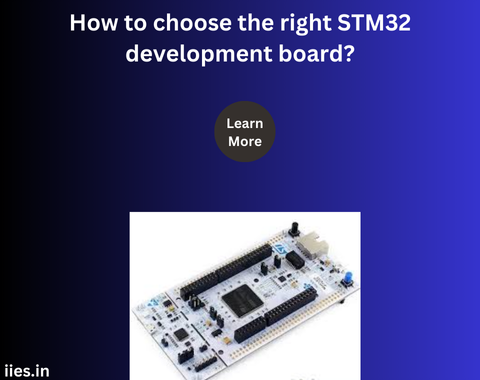
Selecting the appropriate STM32 development board can be a crucial decision for any project, whether you are a hobbyist, a student, or a professional engineer. STM32 microcontrollers from STMicroelectronics are popular due to their versatility, performance, and cost-effectiveness.
However, with a wide range of options available, it can be challenging to determine which board is best suited to your specific needs. Here’s a guide to help you navigate through the selection process.
Consider the processing power needed for your application. STM32 microcontrollers range from basic Cortex-M0 cores to high-performance Cortex-M7 cores. If your project involves simple tasks like sensor reading or basic control, an STM32F0 or STM32G0 series board might be sufficient. For more demanding applications like complex computations, graphics, or real-time operations, you might need the power of an STM32F7 or STM32H7 series.
Assess your project’s memory needs, both Flash and RAM. Simple projects can work with lower memory, but applications that involve large datasets, complex algorithms, or advanced communication protocols might require more memory. Boards like STM32F4 and STM32H7 series offer higher memory capacities.
Identify the peripherals and interfaces you will need. Common peripherals include GPIOs, ADCs, DACs, timers, and communication interfaces like UART, SPI, I2C, CAN, USB, Ethernet, and more. Ensure the development board has enough of these peripherals and that they meet your specifications.
For battery-powered or energy-sensitive applications, consider the power consumption of the microcontroller. STM32L series is designed for low-power applications, offering various power-saving modes and optimizations.
Nucleo boards are a great starting point for many projects. They are cost-effective, have a wide range of supported STM32 microcontrollers, and come with an integrated ST-LINK/V2 debugger/programmer. They are compatible with Arduino Uno R3 connectors, making it easy to expand functionality with various shields.
Discovery kits are feature-rich and typically include more peripherals and interfaces than Nucleo boards. They are designed to demonstrate the capabilities of a specific STM32 microcontroller series and often come with built-in sensors, displays, and other components.
Evaluation boards provide a comprehensive development environment with extensive peripheral support. They are ideal for thorough evaluation and prototyping of STM32 microcontrollers. These boards often include additional features like Ethernet, audio, and camera interfaces.
For specific needs, consider designing a custom development board. This option requires more effort but allows for a tailored solution that exactly matches your project’s requirements.
STM32 development is supported by several IDEs, including STM32CubeIDE, KEIL MDK, IAR Embedded Systems Workbench, and others. Ensure the board you choose is compatible with your preferred IDE.
STMicroelectronics provides extensive software support through STM32CubeMX and STM32Cube firmware packages, which include HAL (Hardware Abstraction Layer) and LL (Low Layer) libraries. Evaluate the availability and suitability of these resources for your project.
A strong community and good support can be invaluable, especially when encountering challenges. Boards with active communities, forums, and extensive documentation can significantly reduce development time and troubleshooting efforts.
While selecting a development board, consider your budget. Nucleo boards are generally more affordable, making them suitable for educational purposes and initial prototyping. Discovery kits and evaluation boards, though more expensive, offer advanced features and peripherals that might be necessary for your project.
Ensure that the development board and the microcontroller it features are readily available. Check for stock availability and potential lead times to avoid delays in your project.
Choosing the right STM32 development board involves a careful assessment of your project requirements, evaluation of available options, consideration of software tools, and budget constraints. By understanding these factors and matching them to the features offered by different STM32 development boards, you can make an informed decision that best supports your project goals. Whether you opt for a Nucleo board for its affordability and expandability, a Discovery kit for its comprehensive features, or an evaluation board for thorough testing, STM32 offers a versatile platform for a wide range of applications.
Indian Institute of Embedded Systems – IIES